We all know that daily walks are key for a happy, healthy canine. But some pet owners find themselves dreading and — heck, maybe even avoiding walks with their dogs due to their pup’s pulling nature.
A pulling dog is no fun to walk and can be very stressful and downright embarrassing.
The good news is — with the right no-pull harness or collar, usage, and training — you can make walks an enjoyable experience again!
We’ll highlight the best no-pull dog harnesses and collars to prevent pulling below, discuss the principles behind different designs, and explain the things you want to look for when making your choice.
A requirement for all no-pull harnesses is a front-clip attachment, as that’s the core method for preventing pulling via harness gear. Back-clip attachment options weren’t mandatory, but considered a bonus. We also took into account the quality of the attachment points — some were better than others.
How much control did it feel like I had over my dog? Not all harnesses have the same design, and some provide more sense of control than others depending on the angle of the straps.
A harness can’t function correctly if it doesn’t fit your dog. Achieving an appropriate fit is absolutely essential for getting a no-pull harness to function as intended, so we’re always looking at the number and quality of adjustment points on the harness.
We also looked at extra features some harnesses offered — like handles (which can be valuable for holding back a lunging canine, or for greater control in busy areas), extra padding to prevent chafing, and reflective trim for better visibility in the evening and early morning.
Best Dog Harnesses For No Pulling: Prevent the Pull!
Let’s dive into our recommended dog harnesses to stop pulling! I’ve tested all these harnesses out myself with my own pulling pup, so let me show you my favorites.
1. 2Hounds Design Freedom No-Pull Harness
A dual-leash harness for more control
The back clip allows your dog to walk comfortably, while the front loop allows you to steer and redirect when needed.
About: The 2 Hounds Design No-Pull Harness is a real fan-favorite — and as someone who uses this harness daily, it’s no surprise that it’s so popular. It’s a real all-in-one harness that I can’t imagine going on a walk without!
The 2Hounds Harness looks simple at first, as its primarily composed of nylon straps. But this harness is actually pretty advanced — not only does it have a front-clip and back-clip attachment option, but it also allows you to clip to these two points simultaneously using the double-connection companion leash.
This double point of contact allows for more control of even the most headstrong pups.
It also features a martingale-style loop on the back-clip section, which provides gentle pressure on your dog’s chest and ribs when he pulls. This slight constriction helps prevent your dog from backing out of his harness, adding even more security.
I also love that this harness’s belly band section is made of soft velour, which can help prevent armpit chafing. And the four points of adjustment make it a breeze to achieve the perfect fit, even on barrel-chested dogs.
One of the common criticisms of front-clip harnesses is that leashes commonly get twisted during walks. But this harness’s vertical, twisting front-clip attachment helps to reduce twisting and tangling to make walks more fun for you and your pooch.
Features:
- Made with strong nylon straps and real metal hardware are both the front and back clip attachments
- Soft velvet lining on the belly band keeps your pup comfy
- Included lead can hook to the front and rear clips for maximum control
- Made in the USA
Pros
- Really can greatly reduce pulling — especially when used in conjunction with training
- Fit and quality are top notch
- Lots of colors to choose from
- Their dual-leash setup offers one of the best leashes for pulling.
Cons
- No reflective stitching for night-time visibility
- On the pricier end when it comes to harnesses
I’ve gone through a lot of different harnesses over the years with Remy, but this one is by far my favorite.
The front-clip option was a lifesaver while I was teaching Remy to walk loose on the leash, and now that we’ve graduated to the back-clip, I really appreciate the added security the martingale cinching loop provides.
Remy also occasionally unhooks his leash from his back-clip when he rolls around on the ground, so the dual-leash setup really allows me to rest easy on walks, no matter what mischief he gets into.
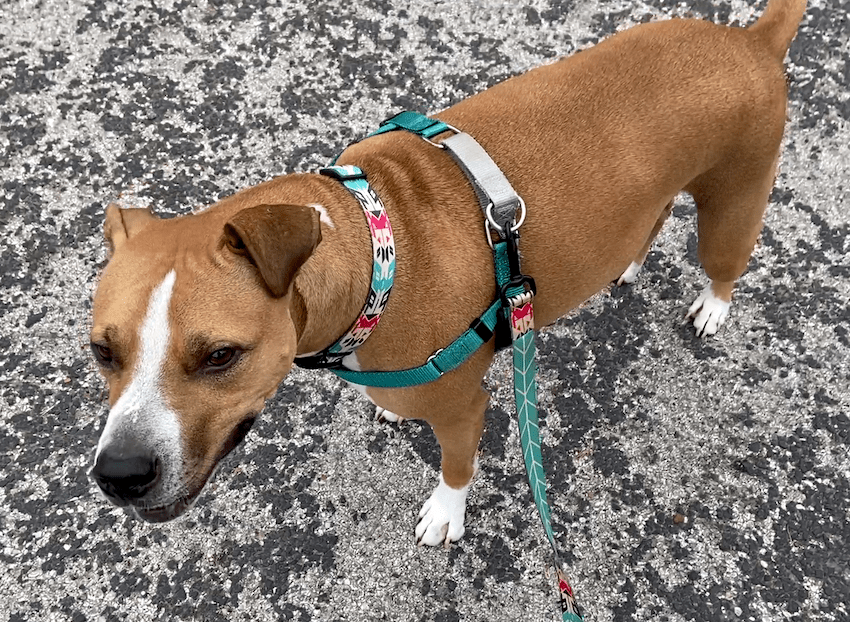
I will say that this harness isn’t cheap.
You can save roughly $10 by purchasing just the harness and using your own leash, rather than opting with their leash + harness set.
But if you have a really tough puller, you’ll definitely want that double-sided leash too as it gives you so much more control.
2. PetSafe Easy Walk Dog Harness
About: The PetSafe Harness utilizes two different no-pull technologies, as it not only comes with a front clip, but it tightens when your dog pulls too.
Front-clip harnesses work by rotating your dog’s body when he pulls — check out our section down below on directional collars and harnesses to learn more about front-clip harnesses and how they operate.
I’ve used this harness a ton for walking dogs at animal shelters, and it’s no surprise it’s such a staple.
Since there’s only one leash attachment at the front, it’s easy to know which part faces the front, so you’re not as likely to get confused or turned around when putting it on your dog.
It even has color coded sections that make it easy to understand which buckle to attach where. This can be handy for owners who get overwhelmed by more complicated buckling setups (and it’s especially a lifesaver when you are crammed in a kennel with a frantic, pent-up rescue pup jumping all over you while a chorus of other neighboring dogs bark like mad).
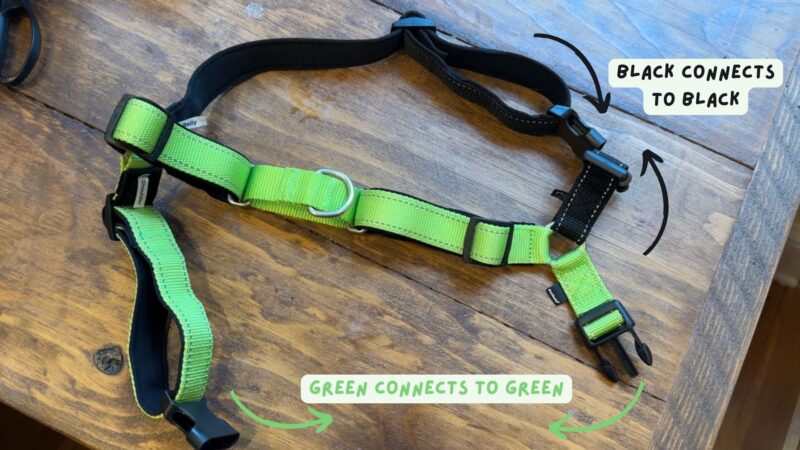
This harness also boasts some really nice padding all over the straps, making it a good choice for dogs who have gotten chafed or had skin irritations from other harnesses. The reflective trim is also a nice touch.
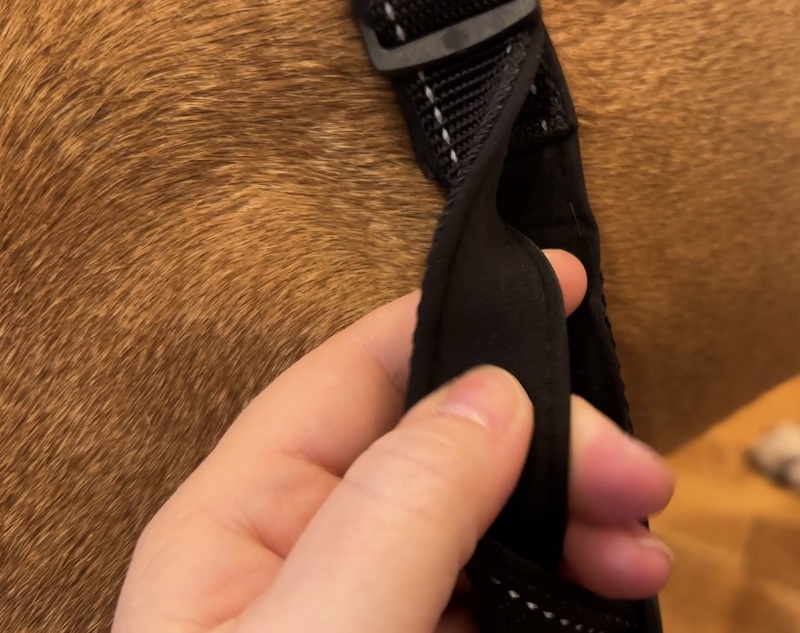
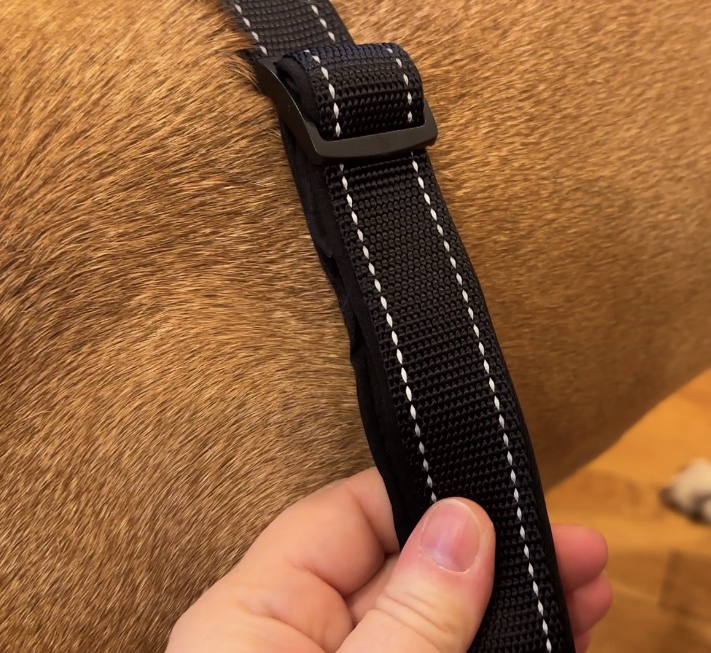
My only qualm is that I personally wish there was a back-clip option, because hopefully with enough loose leash walking training you’ll eventually be able to switch to a back-clip attachment (which is just easier to walk a dog on and is less likely to get tangled).
But, if a loose leash dog isn’t in your near future, the PetSafe Easy Walk is a fantastic choice. There’s a reason why it’s the most well-known no-pull harness on the market!
Simple to use and easy to put on, this is probably one of the best options for first-time dog owners. This harness is frequently a staple of animal shelters across the country, due to its easy-to-use design and effectiveness as preventing pulling.
Features:
- Martingale feature prevents leash twisting
- Made of soft nylon for comfort
- Chest leash attachment to curb pulling
- 4 adjustable points for a secure fit
- Color-coded components make it easy to attach
Pros
- Prevents tugging behavior without choking your pup
- Easy to put on and take off
- Great selection of sizes and colors
- Reflective trim and cushioned padding
Cons
- No back-clip option, which isn’t great once you’ve trained your pup not to pull
3. PetSafe Gentle Leader Dog Collar
About: The Gentle Leader Collar is a head-halter harness that is designed to help eliminate leash-pulling behaviors by controlling your dog’s head, rather than his body.
With one strap around your dog’s muzzle and another around the back of the ears, the head halter fits snuggly on your dog’s head, preventing him from using his chest to pull.
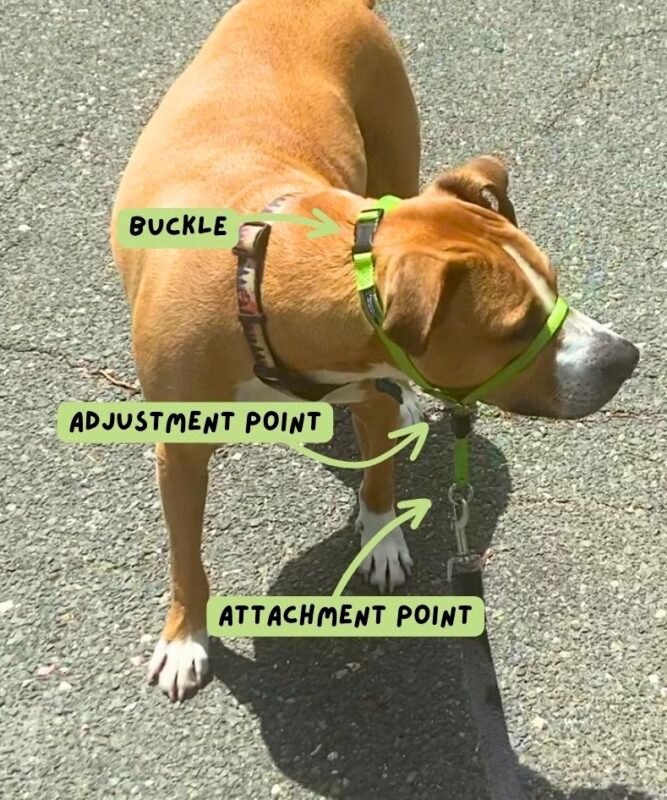
It’s also helpful for keeping your dog’s head up and attention focused where you want it during walks.
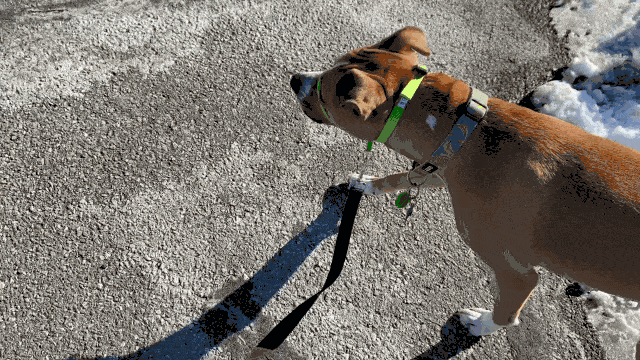
Features:
- Wraps around your dog’s head for a gentle, no-choke solution to pulling
- Adjustable for a customized fit
- Comes with DVD instructions demonstrating safe, effective usage
- Made of nylon with extra padding around your doggo’s snout
Pros
- Quickly stops nuisance pulling in most dogs
- Great option for deep-chested breeds
- No-choke, gentle remedy to pulling
Cons
- Some dogs dislike having something on their face
- Won’t work with flat-faced breeds
- If your dog jerks suddenly, they could damage their neck
I first tried the Gentle Leader on Remy when it was recommended by a trainer I was consulting with in an effort to reduce his reactive barking and lunging on walks.
There’s a lot of mixed messaging on the Gentle Leader, as its a bit controversial.
On one hand, it allows for great control over your dog’s movement without much pressure — your dog can’t put much force behind his head, after all.
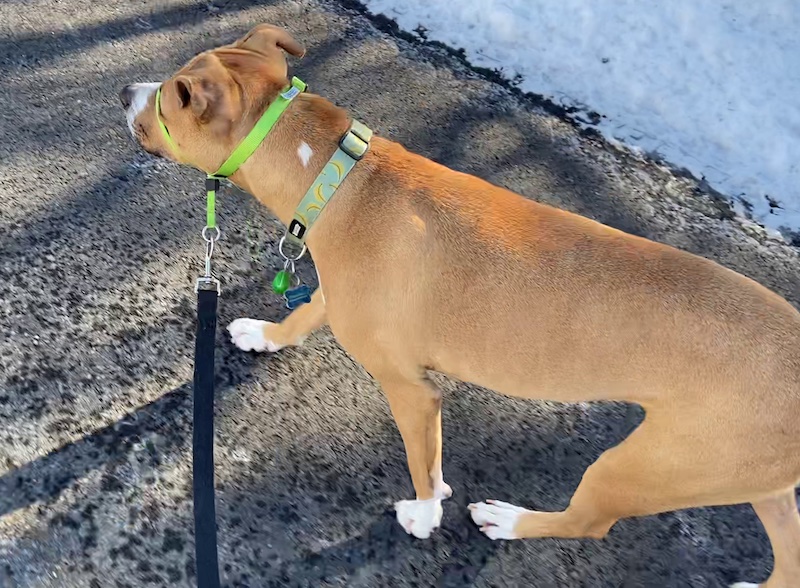
The problem is, in certain circumstances where you yank the leash, or if your dog jerks or lunges, your dog could seriously mess up his neck.
The Gentle Leader can definitely be a game-changer, but you’ll want to make sure you watch the instructional materials that come with it and be careful how you use it.
Also, be ready to do a lot of desensitization work if your dog is skittish or stubborn — Remy actually when on strike and would collapse and refuse to move when I put this head halter on him, so we ended up opting for a different solution!
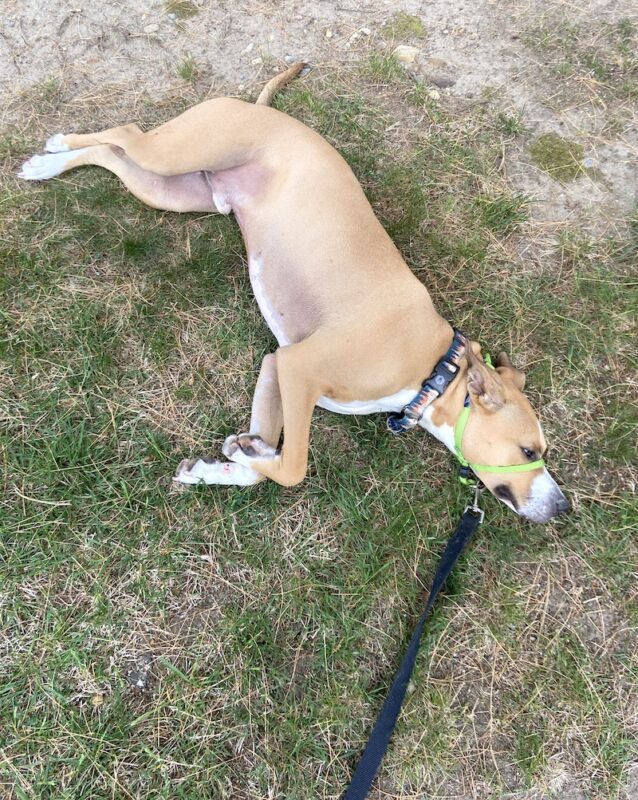
Having a tough time deciding which no-pull gear is right for you? Read our in-depth breakdown of the Gentle Leader vs Easy Walk Harness if you’re struggling to decide between the two!
4. Rabbitgoo No-Pull Dog Harness
A very affordable dog harness that’s made from durable nylon and equipped with two leash clips and a control handle.
About: The Rabbitgoo Harness is a great value dog harness that offers all the essentials without putting a dent in your wallet.
And, since it has a back and front clip option, you can use the front-clip no-pull setup when you need it, while still retaining the ability to use the back-clip if your dog eases up on the yanking.
It also boasts a handle when you need a bit more control. The reflective trim is a nice added bonus as well!
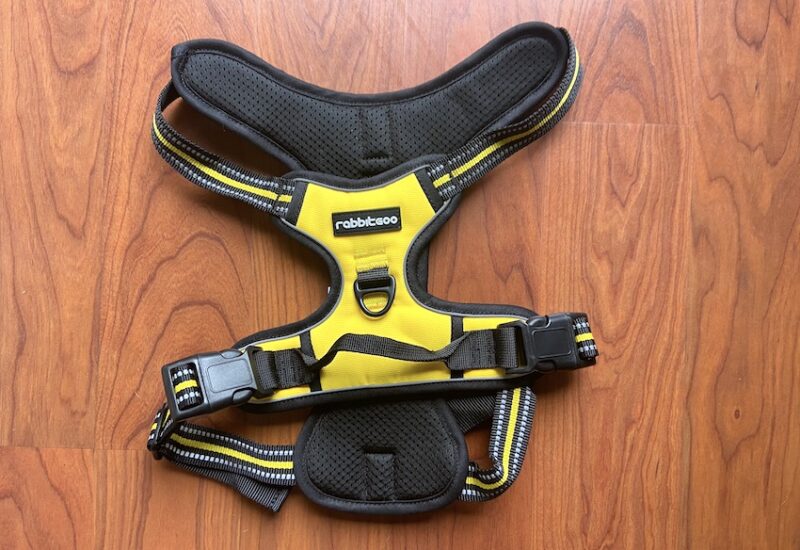
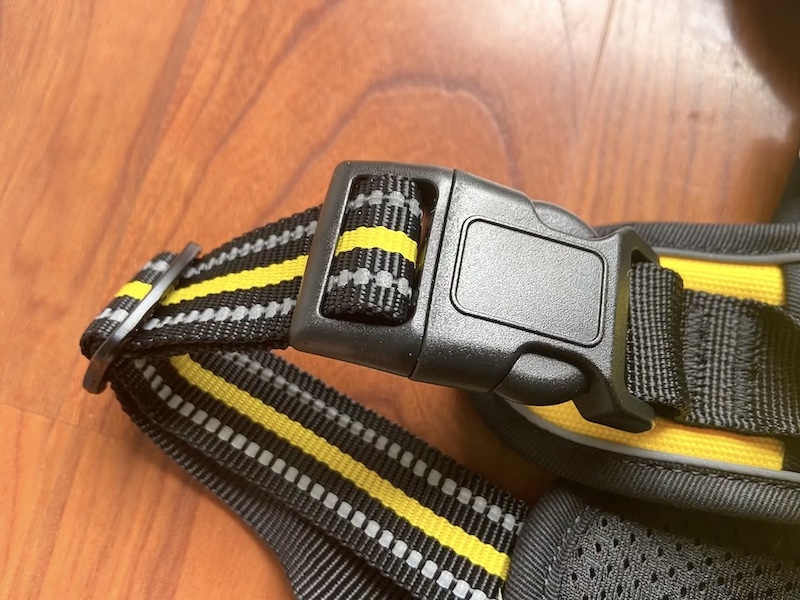
Features:
- Simple step-in design with front and back leash connection points
- Vest design distributes leash pressure away from the neck
- Reflective safety straps for improved visibility
- Back handle for added support over obstacles and control
Pros
- Front clip location helps reduce pulling
- Also has back-clip option for when desired
- Includes a grab handle on the back
- Loads of color options to choose from
Cons
- Sizing can be difficult (they appear to run small)
- A little bulkier than some other harnesses
The Rabbitgoo harness is definitely a win in terms of value — it covers all the basics in terms of harness necessities, and it’s more affordable than most other harnesses on this list.
Honestly though, when I used it with Remy, I just didn’t find it super effective.
Whenever Remy pulled forward, the material would kind of collect in the front and twist around towards me, without moving Remy’s body much.
In theory, this seems like a fitting issue, but I was never able to achieve a fit that really eliminated this issue. I generally have found that the less fabric material a harnesses has, the more stable it seems.
I also found that the back-clip attachment was a lot sturdier than the front-clip attachment. We didn’t have any issues where the front-clip failed… but I think I’d feel a little nervous relying on it with a strong puller. It just doesn’t look all that durable to me.
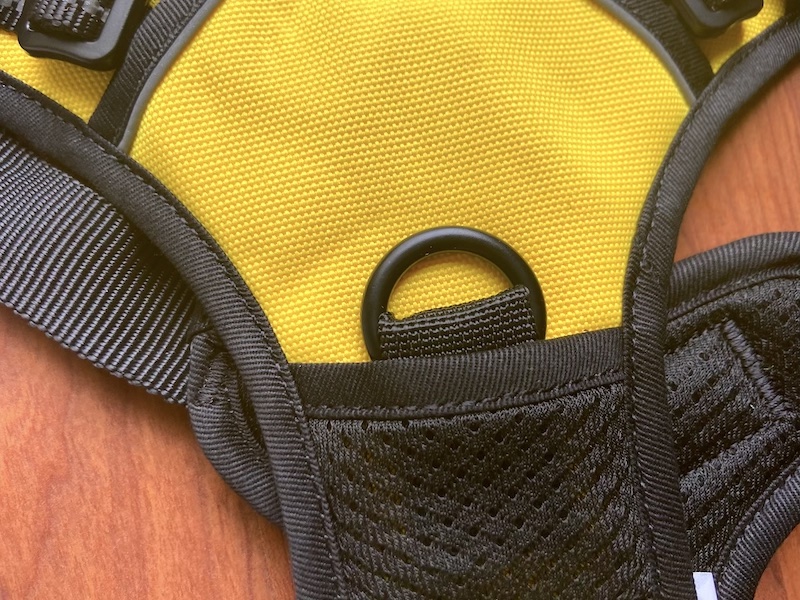
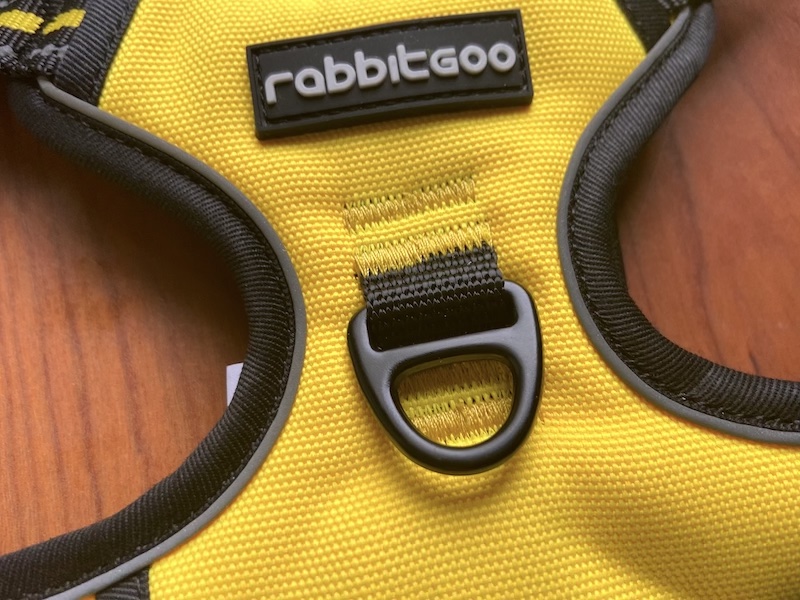
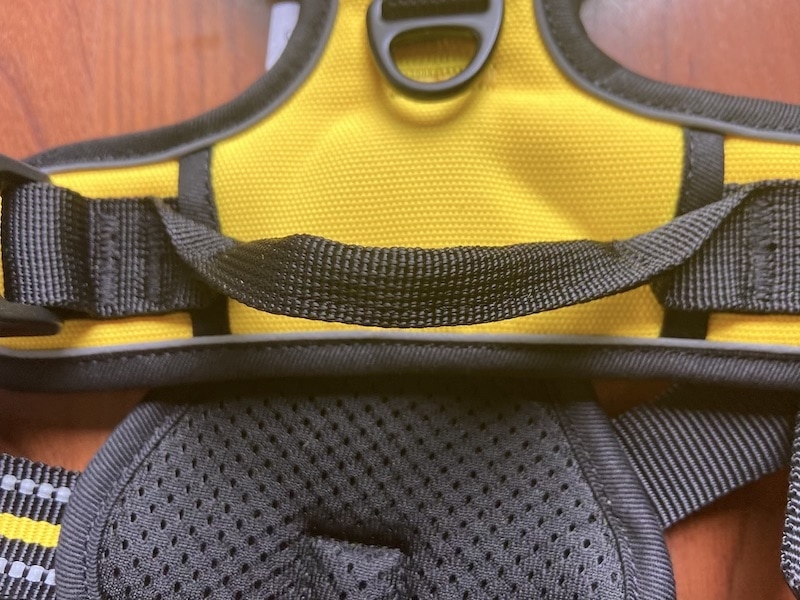
All in all, it’s a fine harness at an unbeatable price, and the front-clip option will probably work fine for a lot of pulling dogs. But if you have a really tough puller, I’d probably suggest the Easy Walk or Freedom Harness instead.

5. Embark Urban Dog Harness
About: The Embark Urban Dog Harness is a quality dog harness that won’t break the bank!
The Embark harness includes adjustable sliders to get the perfect fit, ripstop nylon with plenty of padding, a handy handle for maneuvering tricky terrain, and shiny metal d-rings. It even boasts stitching done with military-grade nylon thread!
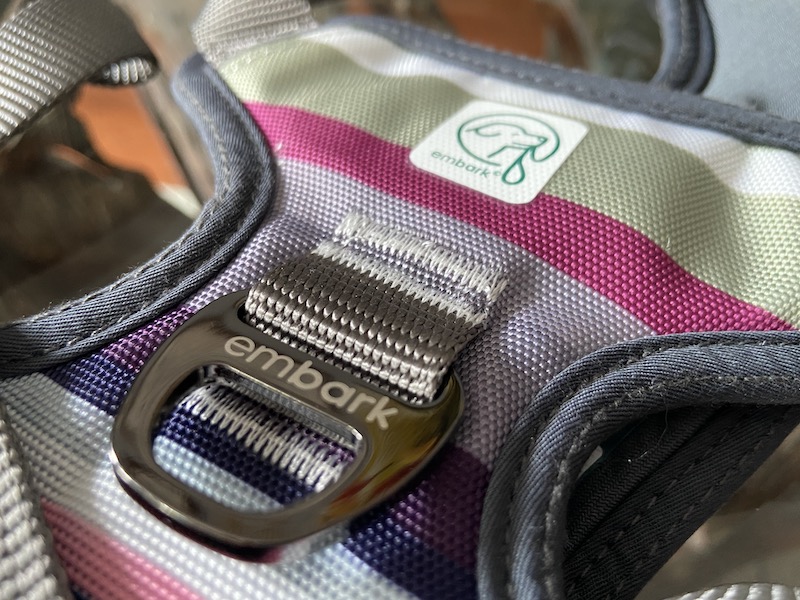
It features leash hook-up clips on the front of the harness as well as at the back. I especially love the handful of unusual patterns available — I personally want something a little more fun than just plain’ old black, am I right?
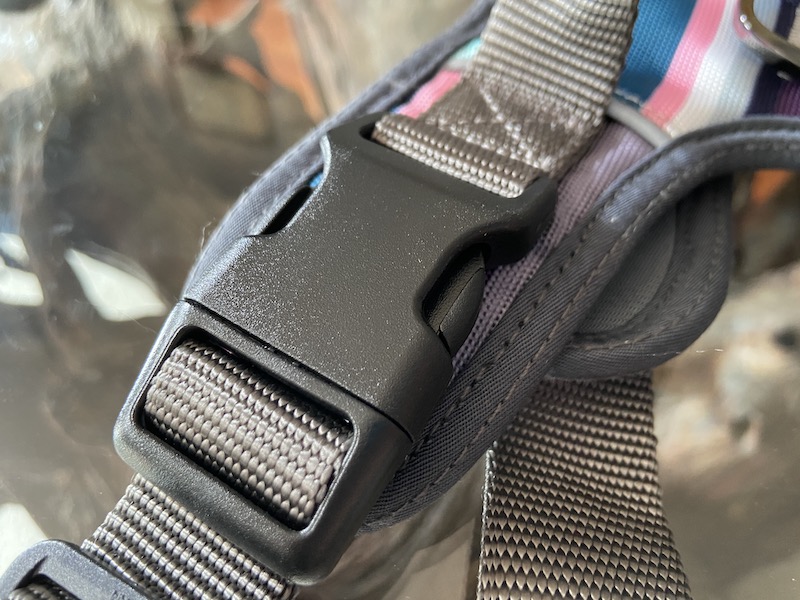
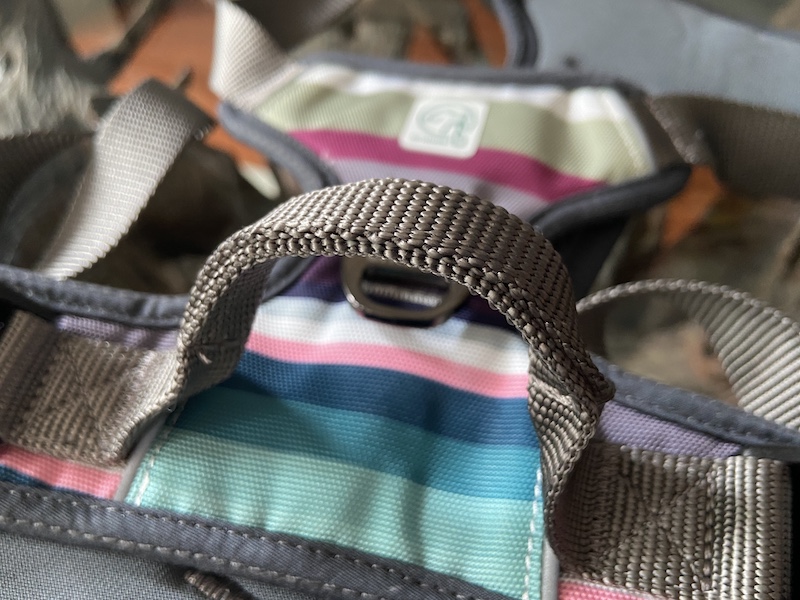
The Embark Harness is very similar to the Rabitgoo in terms of design and value – it’s a solid all-around harness with a no-pull front clip option as well as a back-clip.
And I have to say, I really am a huge fan of the color patterns. They’re just so much more fun than those boring solid colors you see on most dog harnesses.
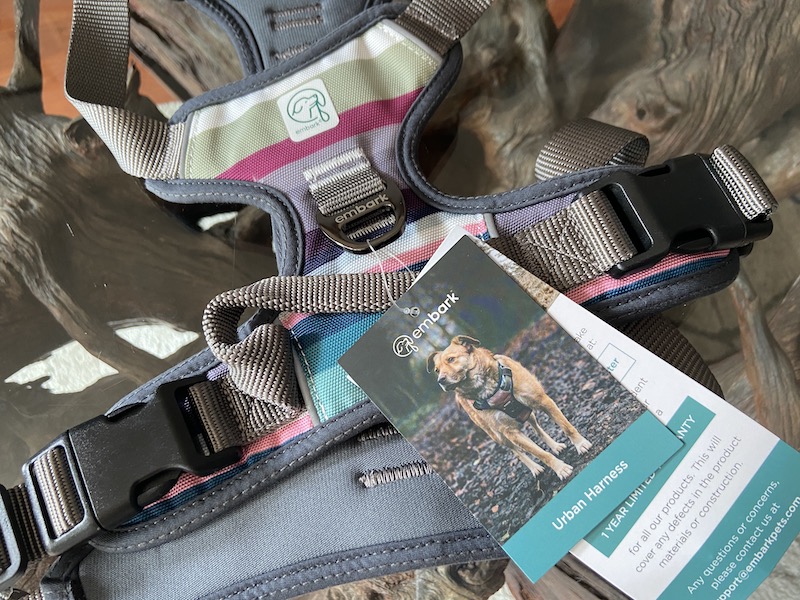
But again, as far as no-pull options go, this harness will probably only work for small to medium-sized dogs. Or dogs who just pull slightly. If you have an XL dog who is dragging you across the street, you’re probably better off with something like the 2Hounds Harness, which offers more control.
Features:
- Front and back connection points provide versatility
- Back handle provides added control when needed
- Non-choke design safely stops tugging without harming your dog
- Made of durable ripstop nylon with reinforced stitching
Pros
- Front connection point helps reduce tugging
- Reasonably priced, especially for the quality
- Unique patterns are available
Cons
- No sizes for toy breeds weighing less than 14 pounds
- A few of the styles are often out of stock
6. Wolfgang Man & Beast Martingale Collar
About: The Wolfgang Man & Beast Martingale Collar is a solid pick for any owner shopping for a martingale.
Wolfgang collars feature large, sturdy collar clips and durable black metal d-rings. But what really sets Wolfgang collars apart are the huge array of bright, unusually patterned designs often inspired by nature, with patterns reminiscent of ocean-side escapes and forested treks.
They’re pretty gorgeous, aren’t they? They really caught my eye and are big conversation starters. Make sure to see their entire pattern collection on the Wolfgang website, as they regularly release new artist series collars with some absolutely wild designs.
Features:
- Tightening mechanism gently applies neck pressure to stop a dog from backing out
- Comes with a limited lifetime manufacturer’s warranty
- Made of abrasion-resistant nylon webbing
- Made in the USA
Pros
- Good choice for quick potty breaks
- Can’t be “backed out of” like traditional collars
- Wide array of unique colors and patterns available
Cons
- Not a good choice for dogs with delicate throats
I’m a pretty big fan of martingale collars, and in particular, I love my Wolfgang one. The collars and patterns are just so cool — I haven’t really seen anything quite like them!
Martingale collars are great because they’re tougher to squirm out of, since they cinch slightly.
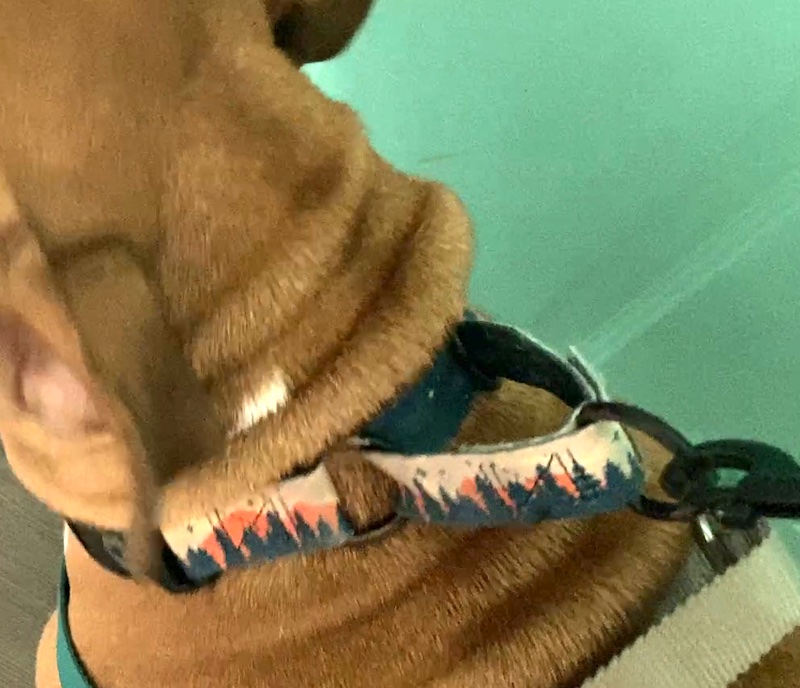
If you have a dog who pulls a lot, they can loosen the fabric of the collar over time, creating an escape risk.
That being said, we don’t support using a martingale collar (or any kind of equipment) to punish or “correct” a dog for pulling.
Yanking a dog around on a collar like this could definitely injure their throat.
So, while a collar like this can be great for quick potty trips, it’s probably not ideal for long walks with super pullers.
Key Features of the Best Dog Harnesses For Pulling
Not all dog harnesses for pulling are made the same. Some may offer unique colors and designs, but do not offer any important functionality.
There are certain elements you’ll want to look for in a pulling dog collar or harness to ensure that it is safe for your dog and functions as intended.
- Soft Material. One of the most important features of an anti-pulling dog harness is the material it is made from. Soft material is best, such as mesh or wool, as it helps keep pressure off the dog and results in a more comfortable collar or harness. A rough collar can rub the dog too harshly and cause irritation. If your dog finds the material uncomfortable, they may start to chew at the harness or collar, which will naturally prove problematic
- Adjustable Sizing. It is also important that the pulling dog harness is adjustable. When it comes to anti-pulling harnesses, one size does not fit all. An adjustable harness or collar ensures the fit is correct for the dog’s size and shape, and it’s even better if there are multiple adjustable points.
- Quick-Release Buckle. A quick-release buckle allows you to get the collar or harness off your dog quickly. This is useful when the dog is pulling away to get back inside the house, or in the case of an emergency.
- Underbody Protection. Harnesses that only focus on protecting the chest do not eliminate all uncomfortable sensations your dog feels. Your dog’s underbody needs extra protection, such as velvet material, to keep your dog’s legs from becoming sore.
- Compression. Some no-pull harness utilize compression, so that when your dog pulls or yanks, there’s a slight cinching effect. This can be really effective for preventing a dog from slipping out of a harness or collar. However, keep in mind that the pressure these compression elements inflict may be damaging to dogs with joint issues or puppies whose bodies are still developing.
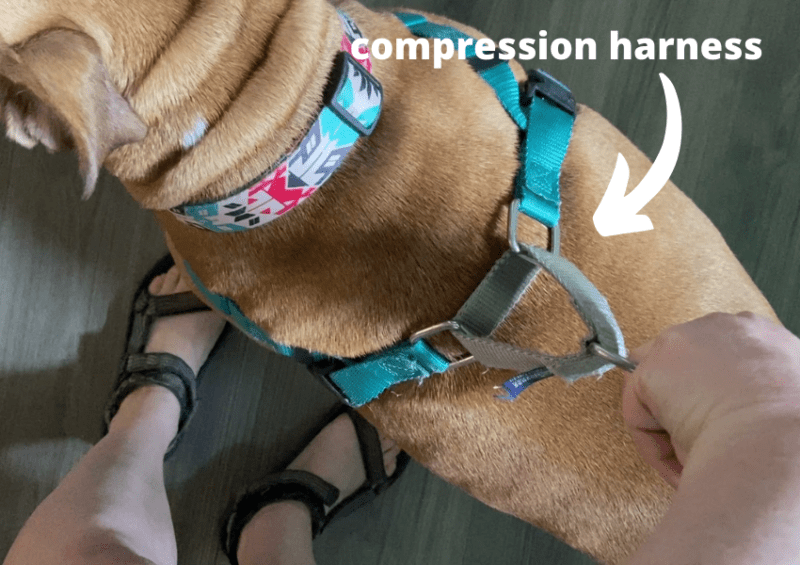
No-Pull Technology: How Do No-Pull Dog Harnesses Work?
Manufacturers use a few different approaches when making no-pull collars and harnesses. That’s great for pet owners and their pets, as it means there are several different options you can choose from on the market.
However, each no-pull technology works a little differently and provides different benefits over a standard collar for dogs. So, you’ll want to make sure you select the best type for you and your pup.
We’ll discuss the most common designs manufacturers use below.
Directional Collars and Harnesses
Directional collars and harnesses make it easy to redirect your dog’s attention and generally improve his on-leash behavior.
Directional harnesses are largely the most popular no-pull tool.
Most harnesses accomplish this via a simple trick — they feature a leash clip that sits between your dog’s front legs, rather than on his back.
This leash clip that sits between your dog’s front legs is referred to as a “front clip”. Many of the best, most popular dog harnesses now include a front leash attachment as well as a traditional back clip, allowing you to choose different leash attachments as needed.
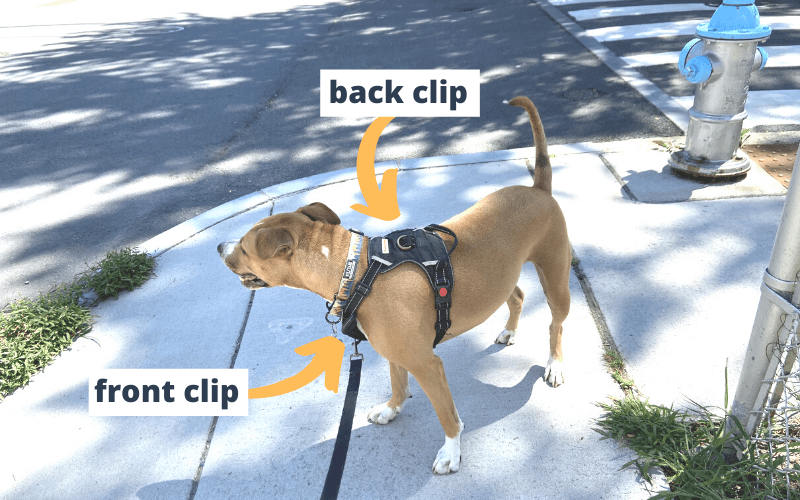
This design prevents your dog from putting his full body weight into pulling.
While a traditional back-clip doesn’t cause a dog to pull, they can certainly put a lot more weight and pressure into their chest against the leash, making the pulling pretty challenging for an owner to deal with.
Think about it this way: Dogs can use all of their strong muscle groups to pull forward, so harnesses that clip on the back force you to pull against your dog’s strongest muscles.
When using a front clip harness, if your dog pulls, instead of being able to use his strength to move forward, he will be turned around to the side. And dogs can’t use their strongest muscle groups when pulled to the side.
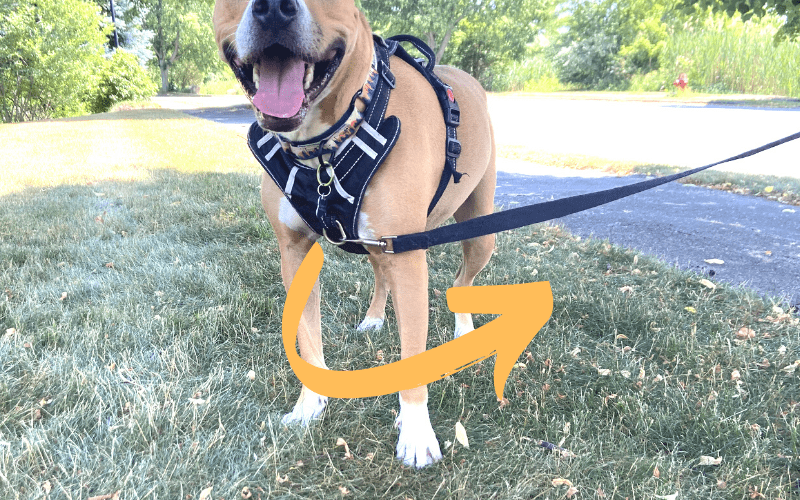
In the clip below, you can get an idea of how this works. Instead of Remy pulling forward, I am pulling back on the leash, but you can see how his body is swung around due to the front clip.
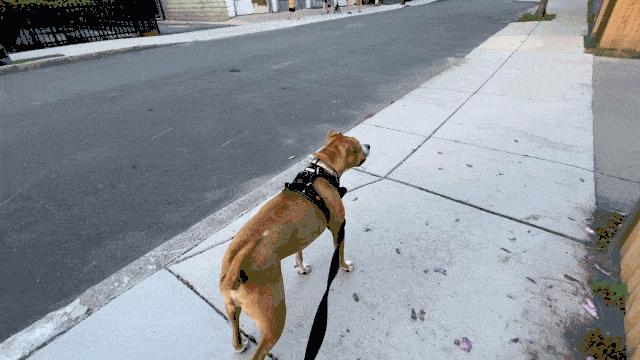
Head halters are another type of directional harness.
These tools work by wrapping around your dog’s head and muzzle, thereby making it easy to direct your dog’s attention where you want and put an end to pulling behavior.
They also tighten slightly when pulled, adding some light compression and preventing your dog from wiggling backing out of the head halter.
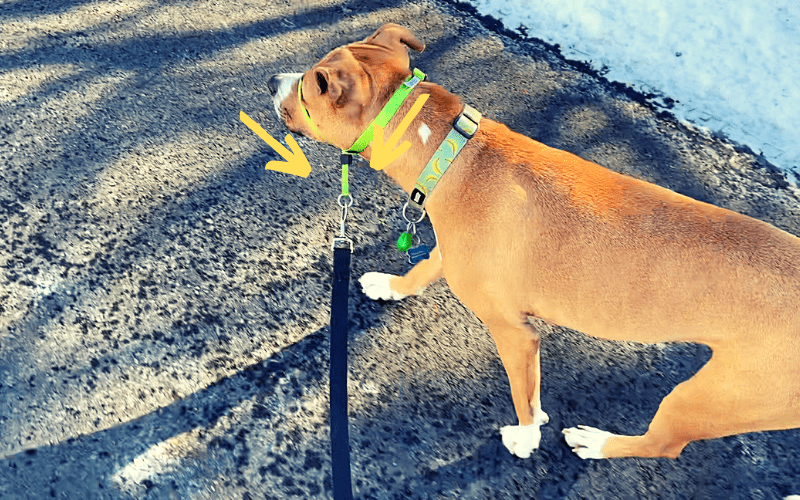
Head halters can be very effective because dogs don’t have much muscle strength in their heads – it’s all about their chests!
Keep in mind that some dogs hate head halters. For these dogs, you’ll need to slowly desensitize them to the head halter in order to get your dog to wear it without trying to scratch it off his face constantly.
Unlike when using a regular collar, dogs can’t really pull while wearing a head halter. However, there are some drawbacks to head halters. Misuse or jerking on a head halter can really damage your pup’s neck.
Some owners also feel nervous with head halters just because it feels like there is so little controlling your dog. In this case, you could always have your dog wear a standard harness with a handle to grab for emergencies, but primarily use the head halter.
Correction Collars (Prong Collars, Chain Collars, Choke Collars, Etc.)
Correction collars are essentially designed to prevent your pooch from pulling during walks by offering you the ability to issue an aversive, in the form of a physical correction, when your dog begins pulling or jerking on the leash.
Chain collars, prong collars, and martingale collars are all examples of correction-style collars.
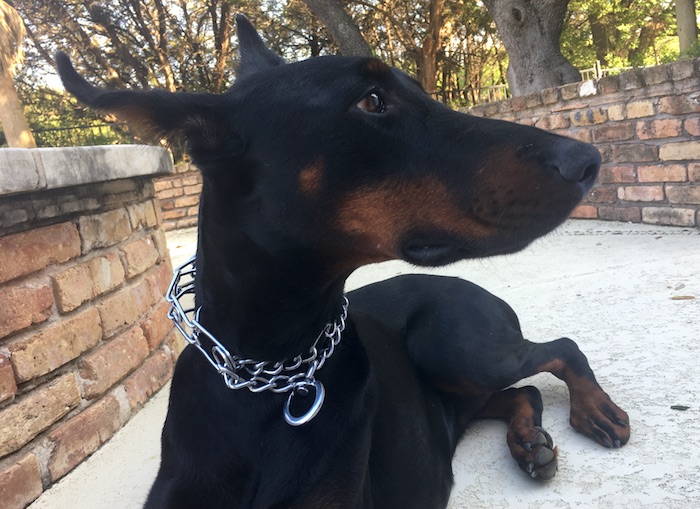
You may notice that we haven’t included any correction collars in this article – that’s because we largely don’t support the use of prong collars or other correction-based aversive tools.
That’s not to say that folks who use prong collars are evil monsters who take joy inflicting pain on their dogs — most owners who use prong collars are just really desperate for a way to stop their dog from pulling.
And we get it — having a dog who drags you all over the street really stinks!
Front-clip harnesses may not work for everyone, and sometimes the benefits of using a prong collar outweigh the downsides.
For example, if a prong collar gives you the confidence to take your dog for long walks, when otherwise you might not walk your dog at all, a prong collar may be worth the tradeoff.
Still, if you choose to use a prong collar or another style of correction collar, it’s important to understand how a prong collar works, as well as the risks involved.
How Do Prong Collars Work to Stop Dogs From Pulling?
Prong collars are effective at preventing your dog from pulling because they inflict pain when your dog pulls. Some people may say the pain is negligible, some may call it discomfort, but whatever you want to call it, the tool is inflicting an unpleasant sensation.
This type of learning is called “positive punishment” – it’s when you add a stimulus (that’s where the positive comes in — think of it more like positive in terms of math, rather than a “good” or “bad” sense) that decreases the likelihood of the dog repeating that behavior (which is what is classified as a “punishment”).
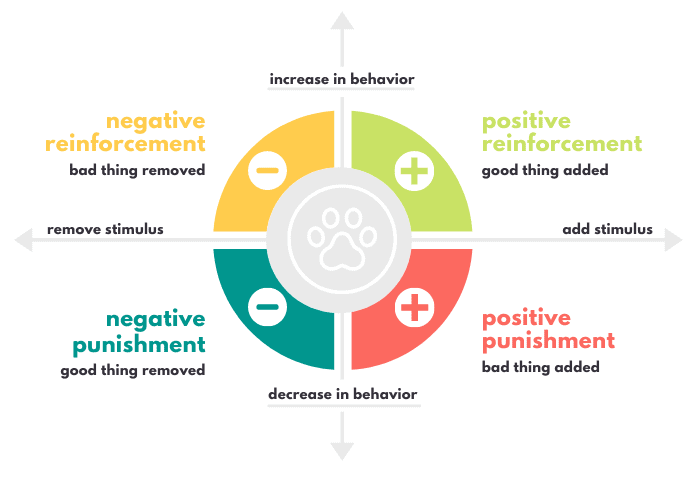
Different people are going to have different thresholds for when they use aversive tools (aka tools that inflict pain) on their pets. Personally, I don’t want to do anything that intentionally causes discomfort to my pet — especially when there are a lot of alternative options out there, like front-clip harnesses and loose leash training.
You’ll find some people who will fight and tooth and nail to claim that prong collars don’t cause any kind of discomfort. But this position doesn’t make any sense — if they didn’t inflict discomfort, they wouldn’t be effective.
How else would one expect these types of collars to prevent pulling?
A knowledgeable balanced trainer will be honest with you about how these tools work. Yes, they do cause discomfort. If you’re OK with that, that’s fine, but if you choose to use a prong collar, it’s important to recognize how the tool works.
Risks Associated with Using Prong Collars (And Other Aversive Tools)
You also need to be really careful about what kinds of associations your dog will be building when pain is involved.
For example, if your dog pulls towards another dog and then experiences discomfort, he may begin to associate other dogs with discomfort.
When these experience build up over time, your dog can end up forming negative, fearful feelings about other dogs. This is why prong and correction collars are an especially terrible idea for reactive dogs, who are already dealing with a lot of fear and stress around other canines.
Dogs with a naturally anxious or nervous disposition are especially at risk, and — since aversive tools like these have been shown to increase cortisol levels — prong collars can potentially exacerbate existing stress and even result in increased aggression or behavior issues down the line.
That being said, some dogs may not experience a lot of ill effects from being on a prong collar. In the end, that choice is going to depend on the individual owner and their particular situation.
If you do choose to use a prong or correction collar, it’s essential that you use it under the guidance of a professional trainer. Choose your trainer carefully, as a lot of so-called trainers have no clue what they are doing and could seriously hurt your dog if they position or use the prong collar incorrectly.
You’ll also never ever want to use a prong or correction collar on certain breeds, such as those with short, “pushed in” faces or weak tracheas. In fact, a harness is likely a safer option for these dogs, regardless of whether or not they pull.
Regardless of the gear you choose, it’s always a good idea to discuss your choice with your vet to ensure that the collar or harness you use isn’t likely to cause an injury based on your dog’s medical history. This is doubly true if your dog has existing joint problems or throat issues.
Tools Won’t Cut It: You Need Training Too to Stop Leashing Pulling!
Many owners make the mistake of thinking that all they need to fix their dog’s pulling is to stop using a standard collar and use the right tool instead.
After all, if the dog’s throat gets pinched or if he gets turned sideways when pulling through the use of the harnesses and collars mentioned above, he’ll stop pulling, right?
Well yes, he will stop pulling – but only when the gear is on!
The best option is to use the tools detailed above in order to give you some training time and allow you to walk your dog in peace when you aren’t training.
BUT – the training work still needs to be done!
In a nutshell: You can train your dog to not pull on the leash by using positive reinforcement when he isn’t pulling. Reinforce his good behavior until it’s the new normal on walks.
Want the full scoop on how it’s done? Make sure to read our training guide on Loose Leash Walking 101: Training Your Dog to Not Pull on Leash!
We also have a full detailed video on how to teach your dog to loose leash walk, which you can check out below!
More Dog Collar and Harness Resources!
Pulling isn’t the only common challenge that dogs can present. Some exhibit problematic chewing behaviors, while others are escape artists, who can quickly slip free during walks.
Because effective collars and leashes are such important tools for all dogs, we’ve written extensively on the subject.
So, be sure to check out the links below to learn more about addressing specific leash, collar, and harness problems.
- Loose-Leash Walking 101 – No matter what type of harness or collar you end up with, you’ll want to train your dog how to behave during walks. We’ll tell you exactly how to do so here.
- Training Collars and Harnesses – Collars and leashes can make effective training tools if you pick the right style and use them correctly. Check out dog trainer and canine behavior expert Kayla Fratt’s recommendations and advice to learn more.
- Correction Collars – If you are thinking about using a chain collar (choke chain), prong collar, martingale, or slip lead, check out our comprehensive review of the subject to learn more about the differences between each and tips for using them properly.
- Best Dog Head Halters – We mentioned one of the best head harnesses around above, but there are other options on the market. Check out this article to see more options and learn a few tips for using these types of harnesses effectively.
- Best Harnesses for Small Dogs – Small dogs often present a unique challenge for owners seeking a harness, as they’re often too small to use a conventional harness safely. But you can find seven great options for small dogs here.
- Chew-Proof Harnesses – Some dogs simply love to get their teeth on anything they can, and this can include harnesses (and leashes too!). Check out this article to see five different options that should stand up to your canine’s chompers, as well as some general tips for using a harness with toothy terriers and power-chewing pit bulls.
- Hiking Harnesses – If you’re the outdoorsy type, and you love taking your pup on wilderness adventures, you’ll definitely want to check out this article. Hiking and camping with dogs presents a few special challenges that you should consider when picking out a collar or harness.
- Escape-Proof Harnesses – Some dogs (particularly lanky breeds, like greyhounds and whippets) are often able to slip free of most ordinary harnesses. Fortunately, there are a variety of harnesses that make it difficult for even the most Houdini-like hounds to do so.
Note that while preventing dog pulling is normally an admirable goal, you may also want to consider harnessing that pulling strength into canicross or bikejoring, if it interests you and your furry buddy.
Regardless, you’ll still want to teach your pup not to pull on regular walks, and for that, anti-pulling harnesses are a must!
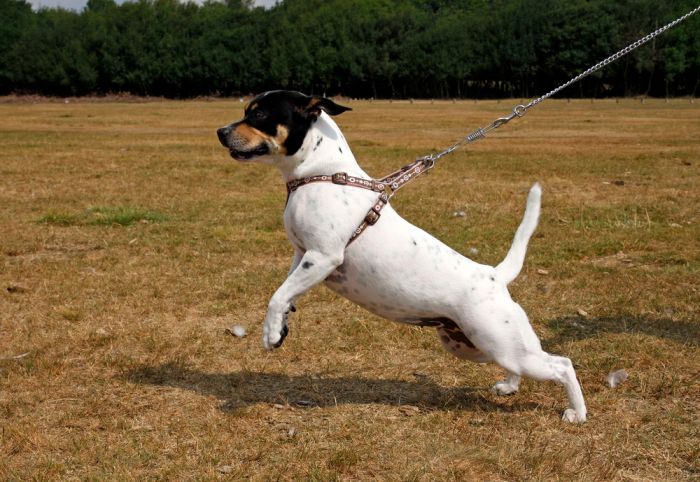
***
What are your favorite dog harness to prevent pulling? Do you have any experience with the dog gear listed here? Have you found one to be particularly effective or have you stuck with using a regular collar?
Share your thoughts in the comments!
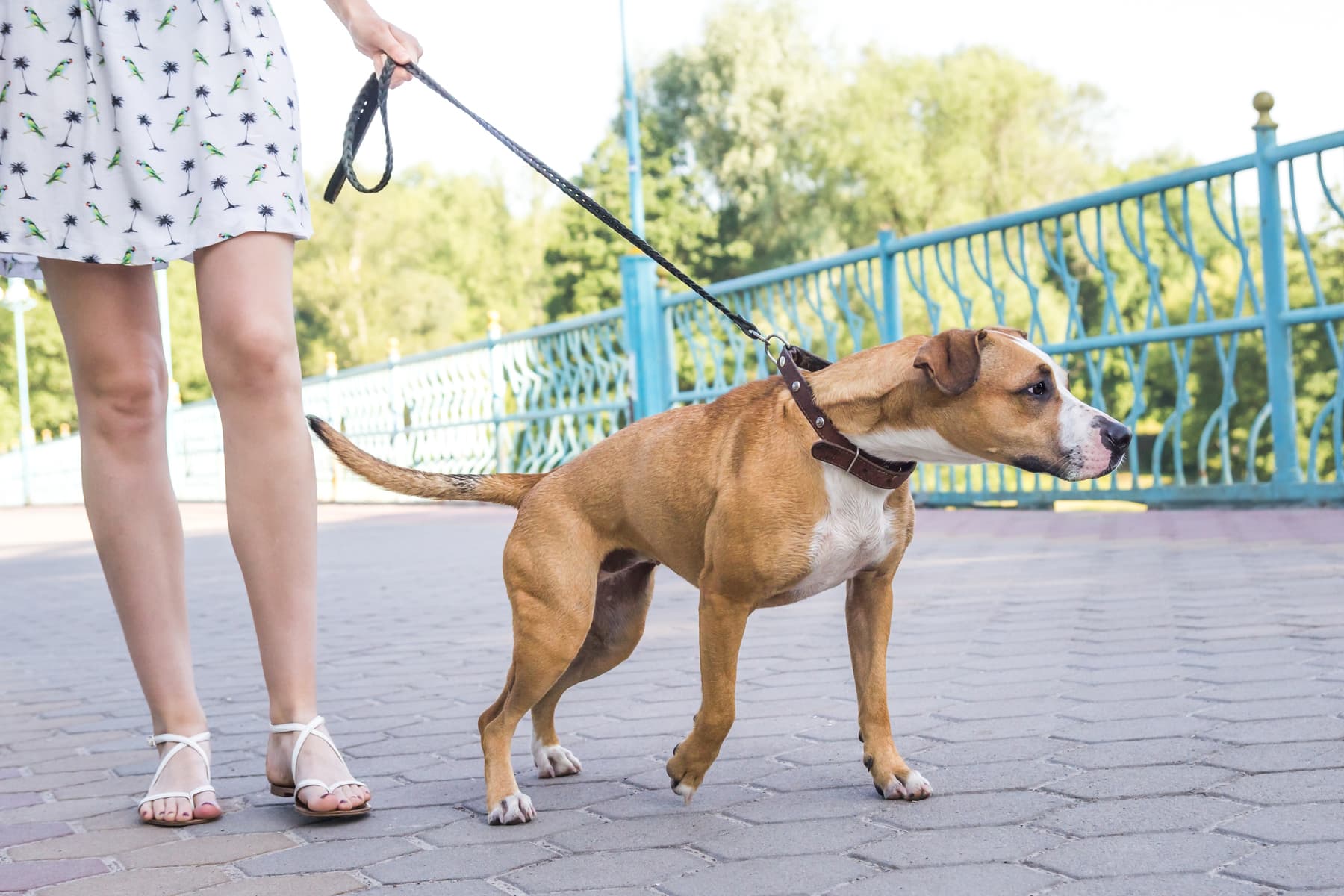
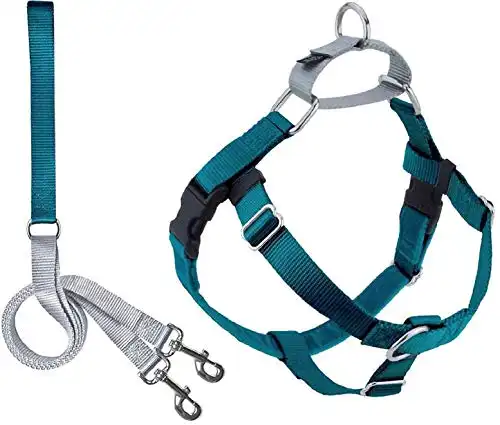
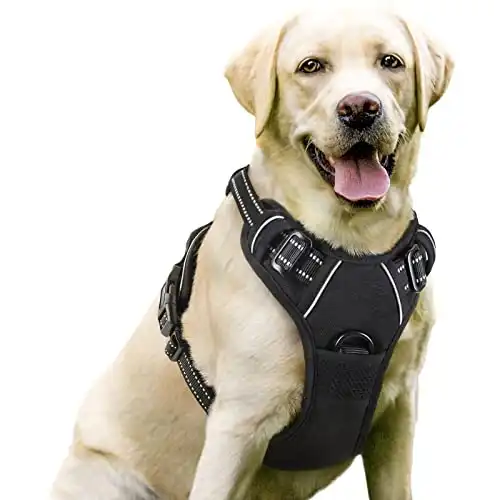




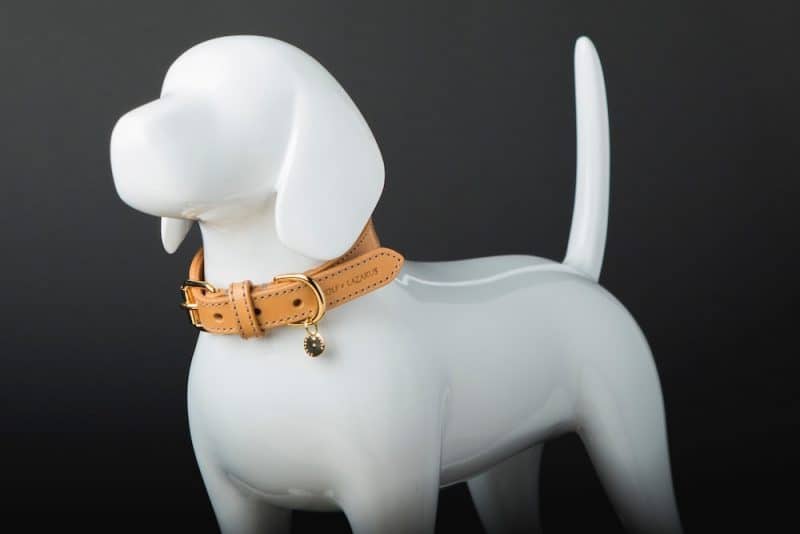
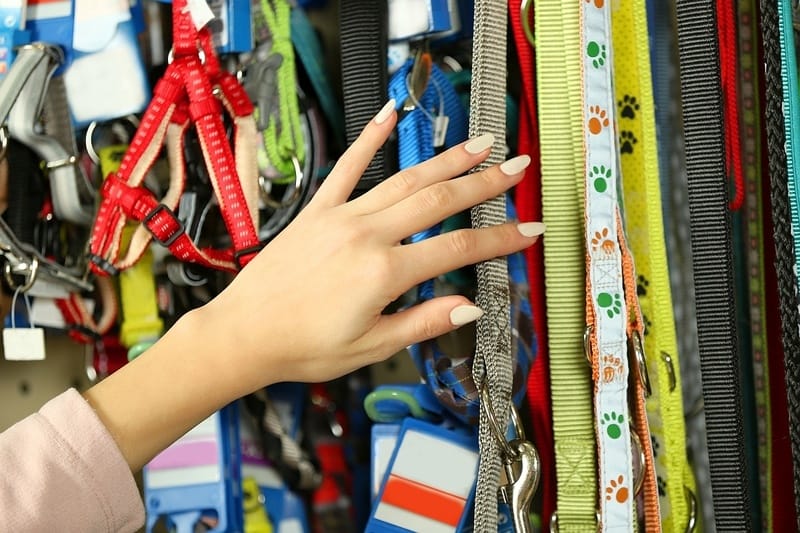

Leave a Comment